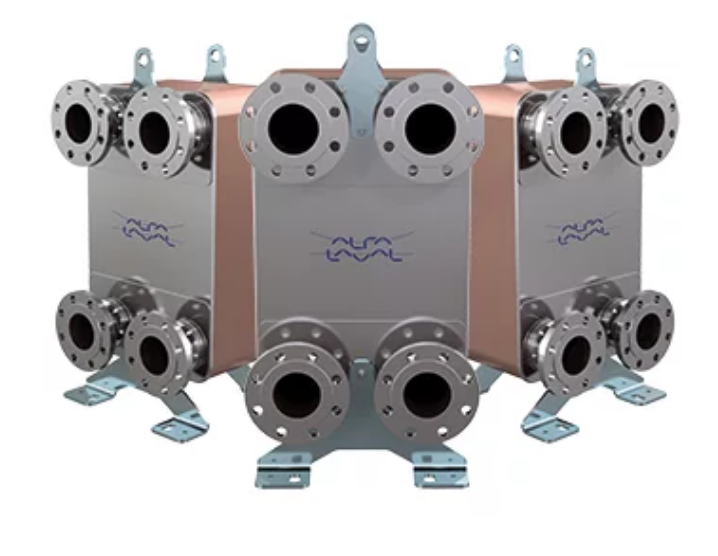 Copper brazed plate heat exchangers provide efficient heat transfer with a small footprint. They are maintenance free, provide a long service lifetime and can withstand high temperatures and extremely high design pressures. They are used in a range of duties including cooling, heating, evaporation and condensing.
Copper brazed plate heat exchangers provide efficient heat transfer with a small footprint. They are maintenance free, provide a long service lifetime and can withstand high temperatures and extremely high design pressures. They are used in a range of duties including cooling, heating, evaporation and condensing.
Brazed plate heat exchangers are widely used in refrigeration plants. They are normally used to transfer heat from the refrigerant – the primary fluid – and from water or brine as the secondary fluid.
Units in the Alfa Laval AC line of copper-brazed heat exchangers are mainly used as:
-
Evaporators for dry expansion and cooling water
-
Condensers for rejecting or recovering heat to water
-
Economizers for cooling liquid refrigerant and super-heating vapour refrigerant.
They can also be used as:
-
Sub-coolers to cool liquid refrigerants using well water
-
Intermediate heat exchangers in the absorption cycle, to preheat the diluted solution or to pre-cool the concentrated solution.

Alfa Laval AC line of brazed plate heat exchangers provide efficient heat transfer with a small footprint. They are specifically developed to work in air conditioning, refrigeration, chillers and heat pump applications.
Efficient heat transfer with an extremely small footprint, making them ideal for demanding installations where space is at a premium, Alfa Laval brazed plate heat exchangers forming a self-contained unit that can handle both high pressures and high temperatures resulting in significant increases in overall efficiency.
HOW IT WORKS

Brazed plate heat exchangers used for HVAC applications normally use a parallel flow to achieve the most efficient heat transfer. In a single-pass design, all the connections are located on one side of the heat exchanger, making installation very easy.
Alternate Channel Pattern
When used as an evaporator, the channels formed between the corrugated plates and corners are arranged so the two media flow through alternate channels, always in opposite directions (counter-current flow). The two-phase refrigerant (vapour + liquid) enters at the bottom left of the unit. The vapour quality depends on operating conditions in the refrigeration plant.
Dry Expansion
Evaporation of the liquid phase takes place inside the channels. Some degree of superheating is always required – hence the process being called “dry expansion”. The dark blue and light blue arrows show the location of the refrigerant connections. The water (brine) to be cooled flows counter-currently in the opposite channel; the dark and light red arrows show where the water (brine) connections are.
AC Line as Condenser
When used as a condenser, the main components are still the same as for the evaporator. The refrigerant enters at the top left as a hot gas and starts to condense on the surface of the channels. Once fully condensed, it is then subcooled slightly, in a process called “free condensation”. The dark and light blue arrows show the location of the brine connections. The refrigerant flows counter-currently in the opposite channel and is cooled. The dark and light red arrows show where the refrigerant connections are.

The Alfa Laval CB range of brazed plate heat exchangers feature efficient heat transfer with an extremely small footprint, making them ideal for demanding installations where space is at a premium. The CB range is used in HVAC heating/cooling, refrigeration, process heating/cooling, oil cooling, solar heating and many other applications.
About CB
The thin, corrugated stainless steel plates used in the CB design are brazed together with copper. This forms a self-contained unit that can handle both high pressures and high temperatures. And unlike traditional designs, the brazed plate heat exchanger consists solely of surfaces that actively contribute to heat transfer, resulting in significant increases in overall efficiency.
The CB range of brazed plate heat exchangers has numerous advantages over traditional heat exchangers in both industrial, HVAC and refrigeration installations. The exceptional heat transfer efficiency makes all CB units very compact. As a result, they can tackle large-capacity duties even though there is only limited installation space available.
The brazed construction also does away with gaskets, making CB units ideal in applications where temperatures and/or pressures are high. Examples include district heating and a wide range of heating, cooling and tap water solutions.
Alfa Laval is the world’s leading manufacturer of brazed plate heat exchangers. This means solid experience in designing units that withstand high-pressure and
high-temperature conditions, and in coping effectively with the structural stresses that results from these. Units in the CB range are available in many different sizes and capacities, with varying plate patterns and connections for particular duties and performance specifications. CB units can be configured as single-pass, dual-pass or multi-pass installations, according to project requirements.
All CB brazed heat exchanger units comply with the European Pressure Vessel Safety Directive, and can also be delivered according to other relevant standards and national codes, as required.
How it works
In Copper Brazed (CB) heat exchangers, the surfaces used to provide heat transfer from one medium to the other are thin, corrugated stainless steel plates stacked on top of each other. The two media are sealed within the plate pack by a brazed copper seal around the edge of the plates. This results in a heat exchanger that – unlike traditional designs – consists solely of surfaces which actively contribute to heat transfer, resulting in significant increases in overall efficiency.
The channels formed between the plates and corner ports are arranged so that the media flow through alternate channels – always in a counter-current flow pattern in order to achieve the most efficient heat transfer.
The contact points between the plates are also brazed, helping to withstand the effects of high pressures and high temperatures. Pressure peaks and rapid temperature cause substantial physical stresses within the materials, and Alfa Laval research has focused on the details of these phenomena in order to ensure designs that are extremely resilient and provide a long service life.





